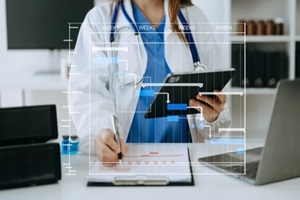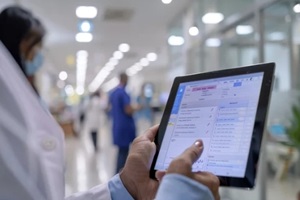Updated on: 3/26/2025
Key Takeaways
- Integration Importance: Healthcare IT integration, particularly with medical claims software, is crucial for modern healthcare delivery, enabling seamless communication between different systems while improving efficiency and accuracy in patient care and administrative tasks.
- Technical Implementation: Successful integration relies on key technologies like HL7 standards, APIs, and middleware, requiring careful planning, system compatibility assessment, and ongoing monitoring to ensure effective operation and data exchange.
- Operational Benefits: Integration delivers significant operational improvements through enhanced efficiency in administrative tasks, improved accuracy in claims processing, and better data management, ultimately leading to better patient care and reduced costs.
The field of healthcare IT is evolving more rapidly than before, with the integration of different healthcare systems and medical claims software being central to driving this unprecedented change.
It’s all about making different software and systems talk to each other smoothly so everything in healthcare, from the admin desks to the operating rooms, all works together seamlessly.
Just imagine all of the different apps and systems in a hospital getting along perfectly and sharing information without a hitch.
That’s the goal here, and it’s an exceptional tool for making everything run better and faster in healthcare settings.
 But why is this so important? When all the systems in healthcare are in sync, doctors and nurses can provide care that’s smarter, more connected, and focused on the patient.
But why is this so important? When all the systems in healthcare are in sync, doctors and nurses can provide care that’s smarter, more connected, and focused on the patient.
It means fewer information mix-ups and better use of time and resources — and in today’s world, where data is pretty much the gold standard, being able to share and use information safely and promptly is a big deal.
After all, it’s what helps healthcare step up its game. As systems increasingly go digital, getting the hang of how integrating different IT systems is becoming a must-do for the healthcare sector.
It’s not just a fancy tech upgrade — it’s a necessity for staying relevant and providing the best care possible for patients.
Benefits of Medical Claims Software Integration
The integration of healthcare IT systems indicates a new era of efficiency and accuracy within the medical field.
Integration plays a vital role in enhancing the operational dynamics of healthcare facilities by enabling disparate software systems to communicate and operate as a unified whole.
Improved Efficiency
Integration significantly optimizes administrative tasks within healthcare settings. For instance, when patient information systems are integrated with medical claims software, data flows seamlessly from one platform to another, eliminating the need for manual data re-entry.
This speeds up administrative processes and reduces the workload on staff to allow them to focus on more essential tasks that require direct human intervention.
An example of this can be seen in a hospital where the integration of electronic health records and laboratory information systems allows test results to be automatically updated in a patient’s record, thus streamlining the workflow and minimizing delays in patient care.
Hypothetically, consider a clinic that adopts an integrated system where appointment scheduling, patient tracking, and billing are all interconnected.
The moment a patient books an appointment, the system automatically updates their records, schedules the necessary resources, and prepares billing information in advance to make the process smoother.
Enhanced Accuracy
The integration of EHRs and medical billing systems significantly enhances accuracy in claims processing and patient record management.
Healthcare organizations can reduce manual data entry errors by automating the flow of patient data from EHRs to billing systems, ensuring that billing and insurance claim processing are more accurate and efficient.
This integration enables real-time data entry and validation while minimizing errors related to illegible handwriting or manual entry mistakes. It incorporates built-in checks and alerts to ensure billing codes adhere to industry standards.
For instance, integrating EHR with medical billing doesn’t just streamline the workflow; it also provides real-time access to patient information, which is vital for accurate billing and claims processing.
It reduces the risk of coding errors while ensuring that your organization is complying with relevant healthcare laws and regulations.
Medical Claims Software Integration Methods and Technologies
 The seamless integration of diverse systems is foundational for efficient operations and effective patient care in healthcare IT.
The seamless integration of diverse systems is foundational for efficient operations and effective patient care in healthcare IT.
Two pivotal elements in this integration process are the Health Level Seven or HL7 standards and the use of application programming interfaces or APIs and middleware.
These components are integral to facilitating robust and seamless data exchange across various healthcare information systems.
HL7 Standards
The HL7 standards represent a global framework for exchanging clinical and administrative information among software applications utilized by diverse healthcare providers.
These standards define a framework and methodology that enable disparate healthcare systems to communicate effectively, ensuring that data exchange is accurate, timely, and interpretable across different systems.
HL7 standards play an important role in the integration of varied systems like electronic health records, laboratory information systems, and medical claims software.
They ensure data integrity and uniformity across these platforms by enabling a comprehensive perspective of patient information.
For example, when a patient’s lab results are transmitted from the LIS to the EHR, HL7 standards ensure that the data is accurately interpreted and correctly displayed in the patient’s record, regardless of the software vendor or platform.
By standardizing the format and structure of data exchange, HL7 facilitates a more streamlined and efficient workflow, significantly reducing the likelihood of errors and misinterpretations that can arise from manual data handling or incompatible system communications.
APIs and Middleware
APIs are instrumental in healthcare integration, facilitating communication and interaction among various software systems.
They act as a bridge that allows one application to access the services or data of another securely and efficiently without needing to know the implementation details of the other system.
Middleware, on the other hand, serves as a mediating layer between different software applications or components, facilitating their interaction and data exchange.
It handles the complexities of data translation and communication between systems that may not use the same protocols or data formats.
The combination of APIs and middleware in healthcare allows for the creation of a flexible and modular IT ecosystem.
For instance, a middleware solution can enable a hospital’s EHR system to integrate seamlessly with a new appointment scheduling app through APIs.
It ensures that when a new appointment is scheduled, the information is automatically updated across all connected systems, enhancing efficiency and reducing the risk of scheduling conflicts or data discrepancies.
Steps for Medical Claims Software Integration
The process of integrating healthcare IT systems is intricate and requires meticulous planning and execution.
These steps are foundational in ensuring that the integration delivers the desired outcomes in terms of efficiency, accuracy, and patient care quality.
Assess System Compatibility
To ensure a successful integration, the initial step involves a thorough assessment of system compatibility which is vital for determining whether different software applications and platforms can communicate and function together efficiently.
Key aspects to consider during this assessment include the compatibility of data formats and adherence to industry standards like HL7, the availability and robustness of interfaces or APIs for data exchange, and the adequacy of existing hardware and network infrastructure.
It’s also important to examine software dependencies and ensure that integration efforts align with stringent healthcare regulations and data security standards.
Once the compatibility assessment is complete, the focus shifts to developing a detailed integration plan.
This plan is the blueprint for the integration process, outlining objectives, scope, and the specific steps needed to achieve seamless system integration.
Develop an Integration Plan
Creating a comprehensive integration plan is pivotal to the overall success of the integration process. This plan should outline the steps, resources, and timeline for the integration, detailing each phase of the process, which includes the following:
 Define Objectives and Scope: Clearly articulate the goals of the integration and define its scope, specifying which systems and processes will be integrated.
Define Objectives and Scope: Clearly articulate the goals of the integration and define its scope, specifying which systems and processes will be integrated.- Data Mapping: Take the time to conduct a comprehensive data mapping exercise to comprehend the data flow between systems. It entails pinpointing the data that will be exchanged, delineating its transformation process, and determining its storage locations.
- Workflow Analysis: Analyze the current workflows to understand how they will change post-integration. This analysis helps identify potential bottlenecks and areas for efficiency improvement.
- Technical Design: Develop a detailed technical design for the integration, specifying the architecture, data flows, interface specifications, and security measures.
- Implementation and Testing: Outline the steps for the actual integration, followed by rigorous testing to ensure that the systems work together as intended. Testing should cover all aspects of functionality, performance, and security.
- Training and Change Management: Plan for adequate training and change management to ensure staff are prepared to use the integrated system effectively.
Monitoring and Maintenance
Once healthcare IT systems are integrated, the work isn’t over just yet. Regular monitoring and maintenance are paramount to help ensure the continuous, efficient, and secure operation of these important and interconnected systems.
Monitoring is essential for detecting any issues early on, such as discrepancies in data exchange or performance bottlenecks, which could impede the functionality of the integrated system and, consequently, affect patient care and operational efficiency.
Effective strategies for maintenance and troubleshooting include setting up a robust monitoring system that provides real-time alerts on system performance and potential problems.
This proactive strategy empowers IT teams to tackle problems before they evolve into major interruptions.
Regular system checks and maintenance routines should be scheduled to ensure all components are functioning correctly and to apply necessary updates or patches that can improve system performance or security.
Moreover, updates should be managed carefully to avoid introducing new issues into a stable environment. Every update ought to be validated in a managed setting prior to its widespread rollout.
For optimization, periodic reviews of system performance and usage data can identify opportunities for fine-tuning and enhancements, ensuring the integrated system continues to meet the evolving needs of the healthcare organization efficiently.
Meet the Leaders of Medical Claims Processing Software Development
The integration of healthcare IT systems is a strategic endeavor that enhances efficiency, accuracy, and the overall quality of patient care.
 The process involves a thorough assessment of system compatibility, a well-structured integration plan, and diligent monitoring and maintenance to ensure the enduring success of the integrated systems.
The process involves a thorough assessment of system compatibility, a well-structured integration plan, and diligent monitoring and maintenance to ensure the enduring success of the integrated systems.
Through the effective utilization of HL7 standards along with APIs, healthcare organizations can achieve seamless data exchange and interoperability among diverse systems, paving the way for more coordinated and high-quality care.
Orases stands out as a leader in the field of medical claims software development, offering solutions that embody the core principles of successful IT integration in healthcare.
Their expertise in creating interconnected systems that optimize administrative tasks, improve accuracy in claims processing, and enhance patient record management positions them as a preferred partner for healthcare organizations looking to leverage technology for better outcomes.
If your company is navigating the complexities of healthcare IT integration and seeks a reliable, experienced partner, consider reaching out to Orases.
They offer a comprehensive 30-minute, no-pressure consultation to discuss your needs so you can explore how their solutions can directly align with your objectives.






